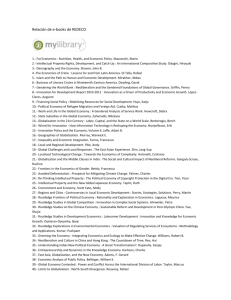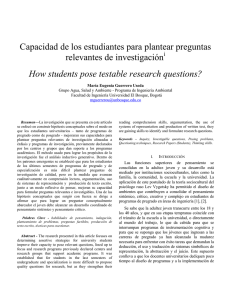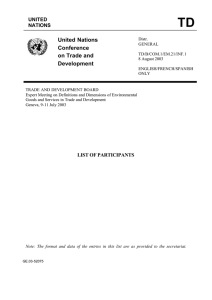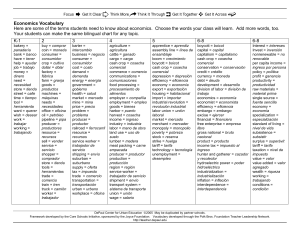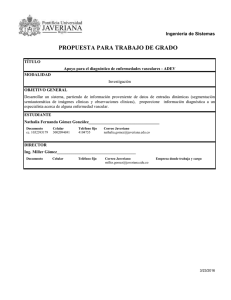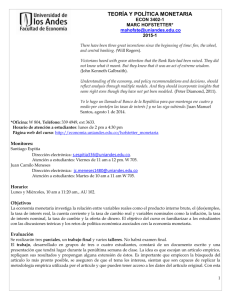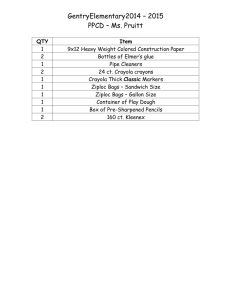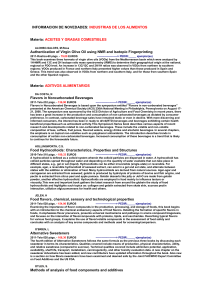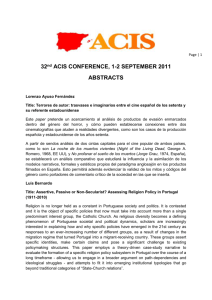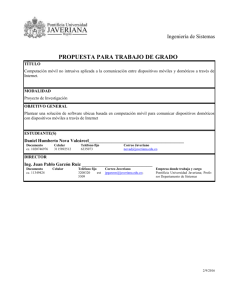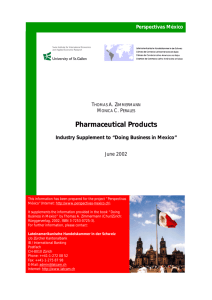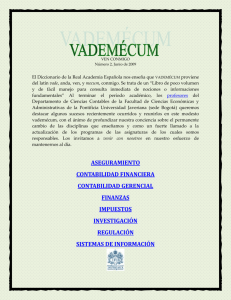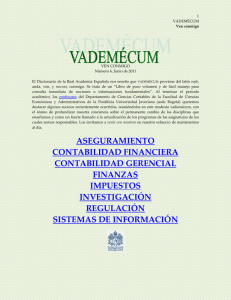OP235SpanishRef - National Bureau of Economic Research
advertisement
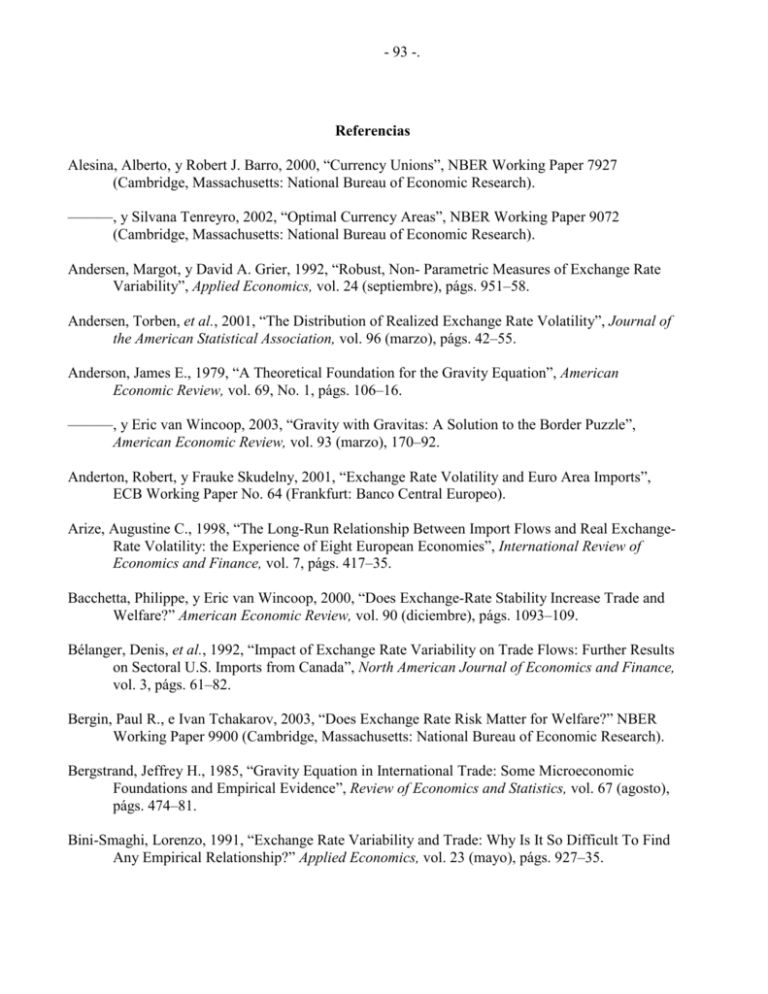
- 93 -. Referencias Alesina, Alberto, y Robert J. Barro, 2000, “Currency Unions”, NBER Working Paper 7927 (Cambridge, Massachusetts: National Bureau of Economic Research). ———, y Silvana Tenreyro, 2002, “Optimal Currency Areas”, NBER Working Paper 9072 (Cambridge, Massachusetts: National Bureau of Economic Research). Andersen, Margot, y David A. Grier, 1992, “Robust, Non- Parametric Measures of Exchange Rate Variability”, Applied Economics, vol. 24 (septiembre), págs. 951–58. Andersen, Torben, et al., 2001, “The Distribution of Realized Exchange Rate Volatility”, Journal of the American Statistical Association, vol. 96 (marzo), págs. 42–55. Anderson, James E., 1979, “A Theoretical Foundation for the Gravity Equation”, American Economic Review, vol. 69, No. 1, págs. 106–16. ———, y Eric van Wincoop, 2003, “Gravity with Gravitas: A Solution to the Border Puzzle”, American Economic Review, vol. 93 (marzo), 170–92. Anderton, Robert, y Frauke Skudelny, 2001, “Exchange Rate Volatility and Euro Area Imports”, ECB Working Paper No. 64 (Frankfurt: Banco Central Europeo). Arize, Augustine C., 1998, “The Long-Run Relationship Between Import Flows and Real ExchangeRate Volatility: the Experience of Eight European Economies”, International Review of Economics and Finance, vol. 7, págs. 417–35. Bacchetta, Philippe, y Eric van Wincoop, 2000, “Does Exchange-Rate Stability Increase Trade and Welfare?” American Economic Review, vol. 90 (diciembre), págs. 1093–109. Bélanger, Denis, et al., 1992, “Impact of Exchange Rate Variability on Trade Flows: Further Results on Sectoral U.S. Imports from Canada”, North American Journal of Economics and Finance, vol. 3, págs. 61–82. Bergin, Paul R., e Ivan Tchakarov, 2003, “Does Exchange Rate Risk Matter for Welfare?” NBER Working Paper 9900 (Cambridge, Massachusetts: National Bureau of Economic Research). Bergstrand, Jeffrey H., 1985, “Gravity Equation in International Trade: Some Microeconomic Foundations and Empirical Evidence”, Review of Economics and Statistics, vol. 67 (agosto), págs. 474–81. Bini-Smaghi, Lorenzo, 1991, “Exchange Rate Variability and Trade: Why Is It So Difficult To Find Any Empirical Relationship?” Applied Economics, vol. 23 (mayo), págs. 927–35. - 94 - Bleaney, Michael, 1992, “Comparisons of Real Exchange Rate Volatility Across Exchange Rate Systems”, Oxford Bulletin of Economics and Statistics, vol. 54 (noviembre), págs. 557–65. Bollerslev, Tim, Ray Y. Chou y Kenneth F. Kroner, 1992, “ARCH Modeling in Finance: A Review of Theory and Empirical Evidence”, Journal of Econometrics, vol. 52 (abril–mayo), págs. 5–59. Broda, Christian, y John Romalis, 2003, “Identifying the Effect of Exchange Rate Volatility on Trade”, manuscrito inédito, Banco de la Reserva Federal de Nueva York y Chicago Graduate School of Business. Brodsky, David A., 1984, “Fixed Versus Flexible Exchange Rates and the Measurement of Exchange Rate Instability”, Journal of International Economics, vol. 16 (mayo), págs. 295–306. Bubula, Andrea, e Ïnci Ötker-Robe, 2002, “The Evolution of Exchange Rate Regimes Since 1990: Evidence from De Facto Policies”, IMF Working Paper 02/155 (Washington: Fondo Monetario Internacional). Caballero, Ricardo J., y Vittorio Corbo, 1989, “The Effect of Real Exchange Rate Uncertainty on Exports: Empirical Evidence”, The World Bank Economic Review, vol. 3 (Washington: Banco Mundial), págs. 263–78. Canzoneri, Matthew B., et al., 1984, “Effects of Exchange Rate Variability on Output and Employment”, International Finance Discussion Papers No. 240 (Washington: Junta de Gobernadores del Sistema de la Reserva Federal). Clark, Peter B., 1973, “Uncertainty, Exchange Risk, and the Level of International Trade”, Western Economic Journal, vol. 11 (septiembre), págs. 302–13. Coe, David T., et al., 2002, “The Missing Globalization Puzzle”, IMF Working Paper 02/171 (Washington: Fondo Monetario Internacional). Côté, Agathe, 1994, “Exchange Rate Volatility and Trade”, Working Paper No. 94-5 (Ontario: Banco de Canadá). Cushman, David O., 1983, “The Effects of Real Exchange Rate Risk on International Trade”, Journal of International Economics, vol. 15 (agosto), págs. 43–63. ———, 1986, “Has Exchange Risk Depressed International Trade? The Impact of Third-Country Exchange Risk”, Journal of International Money and Finance, vol. 5 (septiembre), págs. 361–79. - 95 - Deardorff, Alan V., 1998, “Determinants of Bilateral Trade: Does Gravity Work in a Neoclassical World?” en The Regionalization of the World Economy, J. Frankel, compilador (Chicago: University of Chicago Press), págs. 7–22. De Grauwe, Paul, 1987, “International Trade and Economic Growth in the European Monetary System”, European Economic Review, vol. 31 (febrero–marzo), págs. 389–98. ———, 1988, “Exchange Rate Variability and the Slowdown in the Growth of International Trade”, en Staff Papers, Fondo Monetario Internacional, vol. 35 (marzo), págs. 63–84. ———, 1992, “The Benefits of a Common Currency”, The Economics of Monetary Integration (Nueva York: Oxford University Press). ———, y Bernard de Bellefroid, 1987, “Long Run Exchange Rate Variability and International Trade”, en Real Financial Linkages Among Open Economies, S. Arndt y J. D. Richardson, compiladorres (Londres y Cambridge, Massachusetts: MIT Press). Dell’Ariccia, Giovanni, 1999, “Exchange Rate Fluctuations and Trade Flows: Evidence from the European Union”, en Staff Papers, Fondo Monetario Internacional, vol. 46 (septiembre– diciembre), págs. 315–34. Devereux, Michael B., y Philip R. Lane, 2003, “Understanding Bilateral Exchange Rate Volatility”, Journal of International Economics, vol. 60 (mayo), págs. 109–32. Dixit, A., 1989, “Entry and Exit Decisions Under Uncertainty”, Journal of Political Economy, vol. 97 (junio), págs. 620–38. Edison, Hali J., y Michael Melvin, 1990, “The Determinants and Implications of the Choice of an Exchange Rate System”, en Monetary Policy for a Volatile Global Economy, William S. Haraf y Thomas D. Willett, compiladores (Washington: AEI Press). Ethier, Wilfred, 1973, “International Trade and the Forward Exchange Market”, American Economic Review, vol. 63 (junio), págs. 494–503. Farrell, Victoria S., Dean A. DeRosa y T. Ashby McCown, 1983, “Effects of Exchange Rate Variability on International Trade and Other Economic Variables: A Review of the Literature”, Working Paper (Washington: Junta de Gobernadores del Sistema de la Reserva Federal). Feenstra, Robert C., y Jon D. Kendall, 1991, “Exchange Rate Volatility and International Prices”, NBER Working Paper 3644 (Cambridge, Massachusetts: National Bureau of Economic Research). - 96 - Flandreau, Marc, y Mathilde Maurel, 2001, “Monetary Union, Trade Integration and Business Cycles in 19th Century Europe: Just Do It”, CEPR Discussion Paper No. 3087 (Londres: Centre For Economic Policy Research). Fondo Monetario Internacional, 1984, The Exchange Rate System: Lessons of the Past and Options for the Future, Occasional Paper 30 (Washington). ———, 2003a, Perspectivas de la economía mundial, Estudios económicos y financieros (Washington). ———, 2003b, Exchange Arrangements and Foreign Exchange Markets: Developments and Issues, Estudios económicos y financieros (Washington). Fountas, Stilianos, y Kyriacos Aristotelous, 1999, “Has the European Monetary System Led to More Exports? Evidence from Four European Union Countries”, Economic Letter, vol. 62 (marzo), págs. 357–63. Franke, Gunter, 1991, “Exchange Rate Volatility and International Trading Strategy”, Journal of International Money and Finance, vol. 10 (junio), págs. 292–307. Frankel, Jeffrey A., y Andrew K. Rose, 1998, “The Endogeneity of the Optimum Currency Area Criteria”, Economic Journal, vol. 108 (julio), págs. 1009–25. ———, y Andrew K. Rose, 2000, “Estimating the Effect of Currency Unions on Trade and Output”, NBER Working Paper 7857 (Cambridge, Massachusetts: National Bureau of Economic Research). Frankel, Jeffrey A., y Shang-Jin Wei, 1993, “Trade Blocs and Currency Blocs”, NBER Working Paper 4335 (Cambridge, Massachusetts: National Bureau of Economic Research). Glick, Reuven, y Andrew K. Rose, 2002, “Does a Currency Union Affect Trade? The Time Series Evidence”, European Economic Review, vol. 46 (junio), págs. 1125–51. Greene, William H., 2000, Econometric Analysis (Upper Saddle River, Nueva Jersey: Prentice Hall). Gros, Daniel, 1987, “Exchange Rate Variability and Foreign Trade in the Presence of Adjustment Costs”, Working Paper No. 8704, Département des sciences économiques, Université Catholique de Louvain. Helpman, Elhanan, y Paul Krugman, 1985, Market Structure and Foreign Trade: Increasing Returns, Imperfect Competition and the International Economy (Cambridge, Massachusetts: MIT Press). - 97 - Hodrick, Robert J., 1989, “Risk, Uncertainty, and Exchange Rates”, Journal of Monetary Economics, vol. 23 (mayo), págs. 433–59. Hooper, Peter, y Steven Kohlhagen, 1978, “The Effect of Exchange Rate Uncertainty on the Prices and Volume of International Trade”, Journal of International Economics, vol. 8 (noviembre), págs. 483–511. Hooper, Peter, y Catherine Mann, 1987, “The U.S. External Deficit: Its Causes and Persistence”, Working Paper (Washington: Junta de la Reserva Federal). Kawai, Masahiro, e Iizhak Zilcha, 1986, “International Trade with Forward-Futures Markets Under Exchange-Rate and Price Uncertainty”, Journal of International Economics, vol. 20 (febrero), págs. 83–98. Kenen, Peter, 2002, “Currency Unions and Trade: Variations on Themes by Rose and Persson”, Discussion Paper DP/2002/08 (Wellington: Banco de la Reserva de Nueva Zelandia). ———, y Dani Rodrik, 1986, “Measuring and Analyzing the Effects of Short-Term Volatility on Real Exchange Rates”, Review of Economics and Statistics, vol. 68 (mayo), págs. 311–15. Koren, Miklos, y Adam Szeidl, 2003, “Exchange Rate Uncertainty and Export Prices”, mimeografía, Universidad de Harvard. Krugman, Paul, 1989, “Exchange-Rate Instability”, serie de conferencias L. Robbins (Cambridge, Massachusetts: MIT Press). Kumar, Vikram, y Joseph A. Whitt, 1992, “Exchange Rate Variability and International Trade”, Banco de la Reserva Federal de Atlanta, Economic Review, vol. 37 (mayo/junio), págs. 17–32. Lanyi, Anthony, y Esther Suss, 1982, “Exchange Rate Variability: Alternative Measures and Interpretation”, en IMF Staff Papers, Fondo Monetario Internacional, vol. 29 (diciembre), págs. 527–60. Makin, John H., 1978, “Portfolio Theory and the Problem of Foreign Exchange Risk”, Journal of Finance, vol. 33 (mayo), págs. 517–34. McCallum, John, 1995, “National Borders Matter: Canada-U.S. Regional Trade Patterns”, American Economic Review, vol. 85 (junio), págs. 615–23. McDonald, Robert L., y Daniel Siegel, 1986, “The Value of Waiting to Invest”, Quarterly Journal of Economics, vol. 101 (noviembre), págs. 707–27. - 98 - McKenzie, Michael D., 1999, “The Impact of Exchange Rate Volatility on International Trade Flows”, Journal of Economic Surveys, vol. 13 (febrero), págs. 71–106. Meese, Richard A., y Kenneth Rogoff, 1983, “Empirical Exchange Rate Models of the Seventies: Do They Fit Out of Sample?” Journal of International Economics, vol. 14 (febrero), págs. 3–24. Micco, Alejandro, Ernesto Stein y Guillermo Ordoñez, 2003, “The Currency Union Effect on Trade: Early Evidence from EMU”, Economic Policy, vol. 37 (octubre), págs. 315–43 y 348–56. Mundell, Robert, 1961, “A Theory of Optimum Currency Areas”, American Economic Review, vol. 51 (septiembre), págs. 657–65. Nitsch, Volker, 2002, “Honey, I Shrunk the Currency Union Effect on Trade”, World Economy, vol. 25 (abril), págs. 457–74. Obstfeld, Maurice, y Kenneth Rogoff, 1998, “Risk and Exchange Rates”, NBER Working Paper 6694 (Cambridge, Massachusetts: National Bureau of Economic Research). Organización Mundial del Comercio, 2003, “Trade Restrictions for Balance-of-Payments Purposes—Note on Issues Raised by Developing Countries in the Doha Round”, WT, TF/COH/13 (Ginebra). Pakko, Michael R., y Howard J. Wall, 2001, “Reconsidering the Trade Creating Effect of Currency Unions”, Federal Reserve Bank of St. Louis Review, septiembre/octubre. Parsley, David, y Shang-Jin Wei, 2001, “Limiting Currency Volatility to Stimulate Goods Market Integration: A Price-Based Approach”, IMF Working Paper 01/197 (Washington: Fondo Monetario Internacional). Persson, Torsten, 2001, “Currency Union and Trade: How Large Is the Treatment Effect?” Economic Policy: A European Forum, No. 33 (octubre), págs. 433–48. Pindyck, Robert S., 1982, “Adjustment Costs, Uncertainty, and the Behavior of the Firm”, American Economic Review, vol. 72 (junio), págs. 415–27. Polak, Jacques J., 1988, “The Choice of an Exchange Rate Regime”, en Development Issues in the Current International Monetary System: Essays in Honor of Byanti Khoswaman, Dahlan M. Sutalaksana, compilador (Singapur: Addision Wesley). Pozo, Susan, 1992, “Are Flexible Exchange Rates Really More Volatile? Evidence from the Early 1900s”, Applied Economics, vol. 24 (noviembre), págs. 1213–18. - 99 - Prasad, Eswar, et al., 2003, Efectos de la globalización financiera en los países en desarrollo: Datos empíricos, Occasional Paper 220 (Washington: Fondo Monetario Internacional). Rauch, James E., 1999, “Networks Versus Markets in International Trade”, Journal of International Economics, vol. 48 (junio), págs. 7–35. Reinhart, Carmen M., y Kenneth S. Rogoff, 2002, “A Modern History of Exchange Rate Arrangements: A Reinterpretation”, NBER Working Paper 8963 (Cambridge, Massachusetts: National Bureau of Economic Research). Rogoff, Kenneth, et al., 2004, Evolution and Performance of Exchange Rate Regimes, Occasional Paper 229 (Washington: Fondo Monetario Internacional). Rose, Andrew K., 2000, “One Money, One Market: The Effect of Common Currencies on Trade”, Economic Policy, No. 30 (abril), págs. 9–45. ———, 2002, “Do We Really Know That the WTO Increases Trade?” NBER Working Paper 9273 (Cambridge, Massachusetts: National Bureau of Economic Research). ———, y Charles Engel, 2000, “Currency Unions and International Integration”, NBER Working Paper 7872 (Cambridge, Massachusetts: National Bureau of Economic Research). ———, y Eric van Wincoop, 2001, “National Money as a Barrier to International Trade: The Real Case for Currency Union”, American Economic Review, vol. 91 (mayo), págs. 386–390. Sercu, Piet, y Cynthia Vanhulle, 1992, “Exchange Rate Volatility, International Trade, and the Value of Exporting Firms”, Journal of Banking and Finance, vol. 16 (febrero), págs. 155–82. Smith, Christie, 2002, “Currency Unions and Gravity Models Revisited”, Discussion Paper DP/2002/07 (Wellington: Banco de la Reserva de Nueva Zelandia). Tenreyro, Silvana, 2003, “On the Trade Impact of Nominal Exchange Rate Volatility”, Working Paper 03-2 (Boston, Massachusetts: Banco de la Reserva Federal de Boston). ———, y Robert J. Barro, “Economic Effects of Currency Unions”, NBER Working Paper 9435 (Cambridge, Massachusetts: National Bureau of Economic Research). Tesoro del Reino Unido, 2003, “Euro 2003: EMU and Trade”, disponible en Internet: www.hm-treasury.gov.uk/. Viaene, Jean-Marie, y Casper G. de Vries, 1992, “International Trade and Exchange Rate Volatility”, European Economic Review, vol. 36 (agosto), págs. 1311–21. - 100 - Wei, Shang-Jin, 1999, “Currency Hedging and Goods Trade”, European Economic Review, vol. 43 (junio), págs. 1371–94.
